Willow Oak: Leaves, Bark, Acorns (Pictures): Identification and Growing Guide
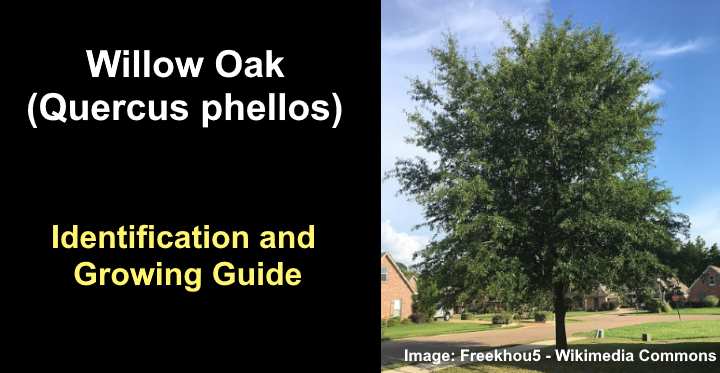
The willow oak tree is a type of native red oak that gets its name from the long, willow-like leathery leaves growing on the tree. The impressive medium-sized deciduous willow oak is known for its fast growth, lush foliage, barrel-shaped acorns, and golden yellow or copper-brown fall foliage. Once established in the landscape, willow oak trees are robust, drought-tolerant and hardy.
This article is a complete guide to identifying a willow oak tree in the landscape. In addition to descriptions of this red oak species, you will also find pictures of willow oak tree leaves, acorns, bark, and flowers. Finally, there is helpful advice on growing a willow oak tree at the end of the article.
Willow Oak Tree Facts
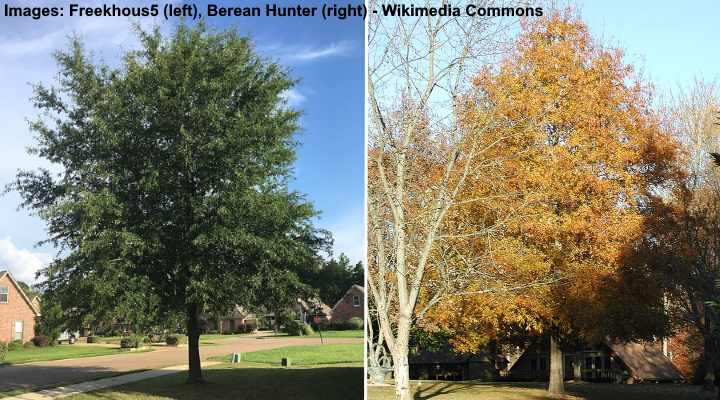
Willow oak trees (Quercus phellos). Right picture: Willow oak in autumn
The willow oak tree (Quercus phellos) is a North American native tree in the genus Quercus and family Fagaceae. The willow oak grows between 65 and 100 ft. (20 – 30 m) tall, and its dark brownish-gray trunk can be up to 5 ft. (1.5 m) in diameter.
Like all trees, the willow oak has specific characteristics making it unique. However, the way to tell the willow oak apart from other oak trees is by its leaves. Unlike the typical lobed leaves of common oak trees, the willow oak has lance-shaped leaves resembling those of a willow tree.
As it matures, the willow oak is identified by its oval, rounded habit with upward spreading branches, a straight trunk, and finely-textured lanceolate leaves. A willow oak can live for more than 100 years.
Willow oaks perform best in USDA zones 5 through 9. The hardy willow oak trees prefer full sun but also grow in partial shade. The robust, hardwood trees are extremely versatile. Willow oak trees thrive in most soil types, including clay soils, that are well-drained and consistently moist.
In ideal conditions, willow oak trees have a medium to fast growth rate. Growing in full sun and well-drained, moist soil, the majestic willow oak tree will grow between 12” and 24” (30 – 60 cm) per year.
Willow oak trees have a fibrous root system that is relatively shallow. This feature makes the willow oaks relatively easy to transplant if necessary. This growth habit of the willow oak also means that it has natural protection against various root diseases, like root rot.
The natural range of the willow oak is from northern Florida and along the east coast to Long Island and then west to Missouri and Texas. The majestic oak with its broad, spreading crown and lush foliage make the willow oak an excellent shade tree in open landscapes.
Related reading: Stunning Florida oak trees.
Willow Oak Tree Leaves
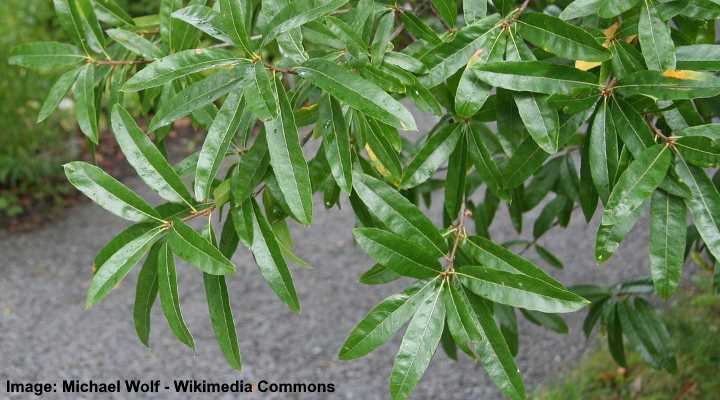
Willow oak leaves
Leaves on the willow oak tree are unusual without the characteristic lobbing of typical oak leaves. Instead, the willow oak leaves are long and slender, lance-shaped, and taper at both ends. The blades have a smooth feel and a shiny green color. In the fall, they turn russet or yellow before dropping.
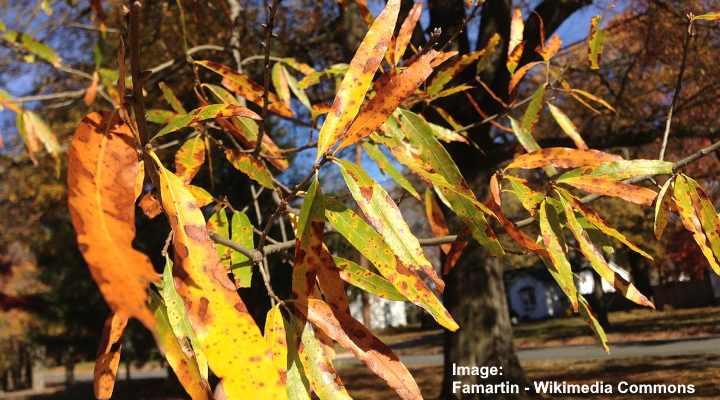
Willow oak leaves in autumn
Willow oak leaves grow 4” to 5” (10 – 12 cm) long and up to 1” (2.5 cm) wide. The willow-like leaves grow alternately on branches. Other features include a bristle tip, smooth edge, and a pale underside with visible veins.
Willow Oak Tree Bark
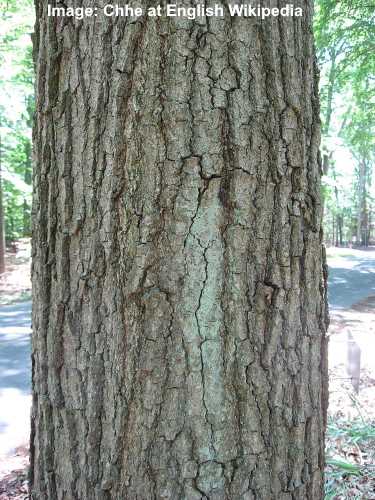
Bark of a mature willow oak tree
The bark of the willow oak tree is smooth and reddish-brown on immature trees. As the oak tree matures, scaly plates with shallow furrows develop and give the tree’s gray bark a rough texture. In addition, mature willow oaks have deeply furrowed grooves and signs of cracking in the bark.
Willow oak twigs emerge olive-brown in color with several reddish-brown terminal buds. As the twigs develop and larger branches grow, they become light gray to gray and retain their smooth texture. Stiff, leathery leaves emerge from small twigs.
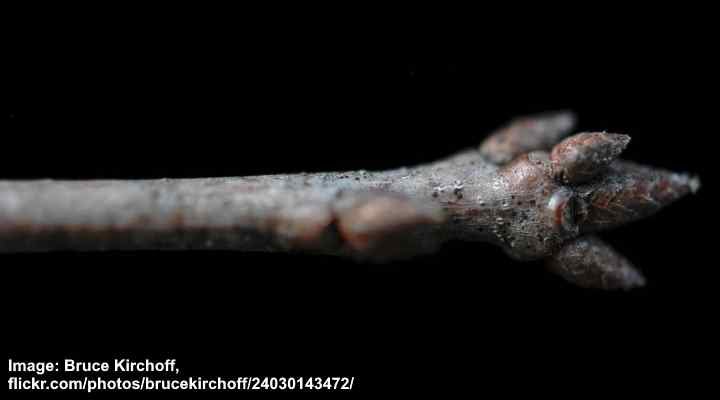
Willow oak twig
Willow Oak Tree Flowers (Catkins)
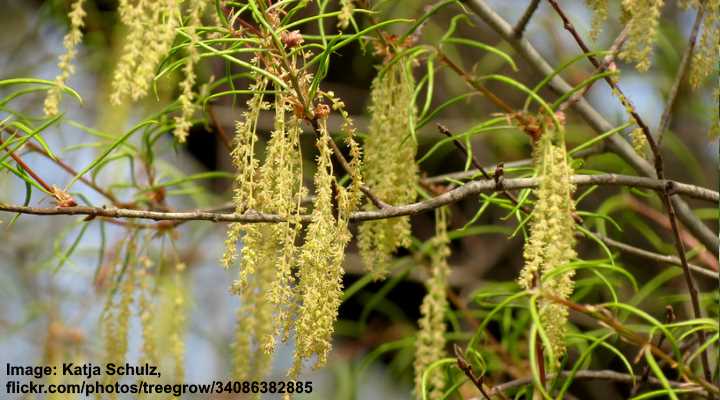
Willow oak male flowers (catkins)
The willow oak is classified as monoecious, meaning that male and female flowers bloom on the same tree. Male willow oak flowers are pendulous yellow catkins (flowering spikes) that grow 2” to 3” (5 – 7.5 cm) long. Willow oak female flowers are small spikes growing in groups of two or three.
Although willow oak is a flowering tree, it’s not known for spectacular blooms. The oak tree blooms in mid-spring. And the pollinated female flowers develop into small, stout acorns.
Willow Oak Tree Acorns (Fruit)
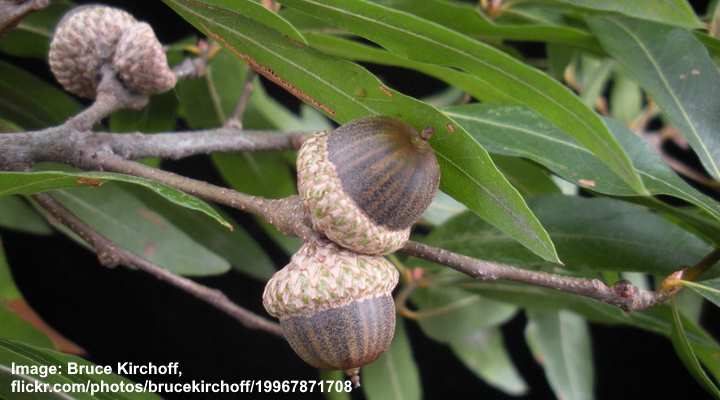
Willow oak acorns
The edible acorns of the willow oak are small and dark brown in color. The small barrel-shaped brown nuts measure 0.31” to 0.5” (8 – 12 mm) long and wide. The willow oak acorns are identified by their shallow, warty cups covering one-third of the nut and pale vertical lines on the thick leathery shell.
Like most species of red oak trees, the willow oak acorns take two years to mature. Although the small oval brown acorns are edible, they have a somewhat bitter taste. However, they are a favorite tree for wildlife.
Willow Oak Tree (Quercus phellos) Identification
A willow oak tree is identified by its leaves, bark, growth habit, and acorns. The stately willow oak has a rounded to pyramidal crown with smooth, leathery willow-like leaves with tapered ends that turn brownish-yellow in the fall. The medium-sized tree has grayish, fissured bark and small dark brown oval acorns.
Where to Plant Willow Oak Tree
The best location to plant willow oak is in full sunlight and moist, well-drained soil. Although the tree can tolerate partial shade, it performs best with six hours of daily sunlight. The location should also allow enough room for the broad pyramidal canopy of 40 feet (12 m).
The willow oak thrives in most soil types — acidic, loamy, sandy, wet, clay, and moist soils. Ideally, slightly acidic soil with a pH level of six or less is ideal. Because the red oak is tolerant of urban conditions, you can plant it as a shade tree in residential parks, roadsides, and extensive gardens.
Because of the willow oak tree’s spreading canopy and shallow, fibrous root system, you should plant the tree at least 25 ft. (7.6 m) from buildings or structures.
How to Plant Willow Oak Tree
The best time to plant a willow oak tree is in the fall. You can plant willow oak acorns directly in the ground, where they will germinate by the following spring. Or, if you have a nursery tree, you can plant the young tree in the fall or spring.
To plant a willow oak, choose the sunniest location in your garden and dig a hole twice as wide as the root ball and just as deep. Then, remove the burlap from the root ball and carefully untangle and uncurl the roots. Finally, set the tree in the hole so it’s growing at the same height as before.
Next, backfill the hole with native soil amended with compost. As you fill the hole, press down as you go to eliminate air pockets. Once the hole is filled, thoroughly water the root area to saturate the ground. Lastly, put a 2” to 3” (5 – 7.5 cm) layer of organic mulch over the root area.
After planting a willow oak tree in the ground, it’s vital to water it regularly to help the roots establish themselves. You should give the newly-planted oak tree about 1” (2.5 cm) of water weekly for the first season. An established willow oak is relatively tolerant of drought.
When planting a willow oak, one thing to remember is its high water and nutrient needs. So, regularly watering the tree will prevent it from drawing moisture from plants in the surrounding area. Also, due to its fast growth, the willow oak quickly absorbs nutrients from the ground.
How to Grow a Willow Oak Tree From Acorn (Willow Oak Tree Propagation)
Growing a willow oak from an acorn is easy and a fun project. The ripe acorns germinate quickly, and the tree’s fast growth means you will soon have a small ornamental tree in your garden or container. To grow an oak from seed, you either have to stratify the acorns or plant them directly in the ground.
The first step is to collect ripe acorns during September and October. To get the best nuts, shake them loose from the tree. Brown ripe acorns easily drop from the tree. Then remove the caps, put the collected acorns in a bucket of water, soak for 24 hours, and discard those that float to the top.
It’s best to stratify the acorns for 30 to 60 days before planting in the soil. Half-fill a sealable plastic bag with moist peat moss. Place the acorns in the bag, seal the bag, and put it in the refrigerator for up to two months. Stratifying the acorns accelerates germination.
To propagate a willow oak from seed, fill a pot that is 1 ft. (30 cm) tall with a well-draining potting mix. Plant three acorns 1” (2.5 cm) in the soil on their sides and press down the soil over them. Water the soil until the excess drips from the drainage holes. Keep the soil moist while germination takes place.
Once the acorns germinate, remove the weaker seedlings. You can move the pot outdoors in April and place it in a sunny location to continue growing. You can transfer it to the ground after the seedling is 6” (15 cm) tall with a few unfurled leaves.
Willow Oak Tree in the Landscape
The ornamental willow oak tree looks beautiful in an open landscape. It is an excellent shade tree in a large lawn or extensive garden. It will also grow well in damp conditions where other oak trees struggle. However, its spreading canopy requires a lot of room.
Willow Oak Tree Care Guide
A willow oak is relatively easy to care for. The medium to large deciduous tree adapts to most soil types and can withstand heat, drought, and urban environments. The tree requires little care when growing in full sun and well-drained soil.
How to Water Willow Oak Tree
Newly planted willow oak trees require watering at least twice a week, or whenever the soil feels dry. This helps the oak tree establish deep roots and prevents it from absorbing excessive moisture from surrounding plants. You can use a drip irrigation system or hose to water your willow oak tree.
Mature willow oaks only need watering during prolonged periods of drought or when rainfall drops below one inch per week. You may need to water the willow oak once a week or once every two weeks in hot, dry summers. During winter, when the oak is dormant, you can hold off watering altogether.
Willow Oak Tree Fertilization
Willow oak trees benefit from a bi-annual application of a balanced fertilizer for trees. You can apply a slow-release fertilizer with an NPK rating of 10-10-10 in late winter and midsummer. This will help the tree develop abundant leafy foliage and boost its health to make it resistant to disease.
It is vital to avoid fertilizing a willow oak tree after August until the end of winter. Fertilization during fall and winter can stimulate new growth, which will die off in freezing temperatures. Also, it’s crucial to follow the manufacturer’s instructions regarding the amount of fertilizer to apply for the size of the tree. Otherwise, you may end up with scorched leaves due to root burn.
How to Prune Willow Oak Tree
Willow oak trees require pruning when immature to remove upright-growing branches. The goal is to identify the central leader and remove any competing stems. Compared to other oak trees, willow oaks take longer to heal from cosmetic pruning. Therefore, it’s vital to do all structural pruning when the tree is relatively immature.
An established willow oak only requires pruning to cut off dead or diseased branches. Also, remove branches that are crisscrossing or rubbing against other limbs. It is also possible to thin out the tree’s crown. However, it’s best to call the professionals to prune a mature willow oak tree.
Pests Affecting Willow Oak Tree Growth
Willow oak trees are hardy deciduous trees that are resistant to pests. However, in some cases, aphids, scale insects, caterpillars, or boring insects can affect willow oak’s health.
Willow oak foliage damage by caterpillars: Various types of caterpillars can attack willow oak leaves. For example, tussock moth larvae, fall webworms, and tent caterpillars can chew on leaves and cause severe leaf damage. Usually, gypsy moth caterpillars are particularly destructive on willow oaks. However, most oak tree caterpillar damage is only cosmetic.
Aphid damage to willow oaks: Aphids are tiny foliage-destroying bugs that cause distorted leaf growth. You may notice honeydew — a sticky, amber-colored substance — on the lower leaves. Find out how to kill aphids on outdoor plants.
Scale insect damage on willow oak trees looks like small reddish-brown ball-like growths that appear on twigs and branches near leaf stems. Oak tree damage by scale insects can cause die-back and impact new leaf growth.
Spider mites can also affect willow oak tree foliage. If the infestation becomes severe, the signs of mite damage on oak foliage are a dusty coating on leaves, and then the leaves may start to turn yellow. Learn how to eradicate spider mites from plants.
Diseases Affecting Willow Oak Tree Growth
Willow oak trees growing in ideal conditions are typically healthy trees that are resistant to fungal and bacterial diseases. However, some tree diseases affecting willow oaks include anthracnose, canker diseases, oakleaf blister, powdery mildew, and bacterial leaf scorch.
Willow oakleaf blister is a fungal disease that causes round, brown raised areas on the upper leaf surfaces. The leathery oak leaves may have a bumpy appearance of the same shape and size on lower leaf surfaces. Although it’s a problem in wet seasons, it won’t harm the tree.
Anthracnose can be a serious problem in wet, cool weather, causing dead patches on infected leaves. In many cases, premature leaf drop is common. And in stressed trees, the disease can cause the tree to die eventually. However, the fungal infection rarely causes lasting damage to a willow oak tree.
Powdery mildew affects willow oak trees due to issues with humidity, poor air circulation, and cool weather. Symptoms of powdery mildew include a whitish powdery growth on leaves, which appears sprinkled with black pepper. This disease is common in late fall but is mostly cosmetic and doesn’t harm the tree’s health.
Related articles:
